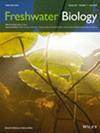Comparing Methods for Estimating Geographic Ranges in Freshwater Fishes: Several Mirrors of the Same Reality
IF 2.7
2区 生物学
Q2 ECOLOGY
引用次数: 0
Abstract
- Describing the geographic range of aquatic species is crucial for biodiversity conservation and management. This study comprehensively assesses commonly used methods for constructing geographic ranges and estimating their sizes in freshwater environments, focusing on the Curimatidae family of tropical freshwater fishes distributed in Central and South America. Our main objective was to evaluate different range estimation methods, including convex hull polygons, alpha-shape polygons with a fixed alpha-value, dynamic alpha-shape polygons, expert maps and species distribution models (SDMs).
- We used georeferenced data from various sources to delineate species' ranges within their hydrographic basins of occurrence. Geographic ranges for each species were reconstructed using the five methods. For the four polygon methods (i.e., excluding SDMs), two ranges were constructed: (i) polygons considering the whole terrestrial surface (unrestricted) and (ii) polygons considering only freshwater bodies (restricted). Specific environmental variables of freshwater systems were employed for the SDMs. Then, we assessed the differences in range sizes among methods and within each method (excluding SDMs) considering unrestricted and restricted polygons.
- Our results revealed significant variations in range size estimates among the methods. Specifically, the convex hull method produced larger range sizes than the other methods. Additionally, our comparison between range size estimates using unrestricted and water body-restricted polygons revealed a consistent trend: unrestricted polygons estimated ranges that were eight times larger than those restricted to water bodies. Moreover, restricting polygons to water bodies resulted in ranges closely matching those estimated by SDMs, indicating the effectiveness of this adjustment procedure.
- We highlight the notable variability in range size estimates among different methods, underscoring the need to carefully select the one appropriate for given research goals. For example, expert maps could be helpful for quick assessments of species' distribution and diversity when these are readily available. Convex hulls are suitable for quickly identifying potential conservation areas and assessing the overall species range in biodiversity monitoring. Dynamic alpha is appropriate for species with fragmented distributions, as they can capture discontinuities in range delimitation. Static alpha provides a balanced method for range size estimation when ecological information is limited, offering a practical solution for ecological and conservation assessments. SDMs are ideal for detecting species-environment relationships and identifying unexplored areas where a species might occur. Additionally, adjusting estimated ranges by considering the species' life forms, in this case, associated with water bodies, explicitly restricts their distribution to the actually occupied habitats.
- Although we focused on the Curimatidae fish family, our study has implications applicable to other freshwater species, providing crucial information on the variability in range size estimates. By thoroughly assessing the methods and their impacts on range size estimates, our study contributes useful guidelines for selecting the appropriate method based on data availability, its spatial arrangement and specific research goals. This contributes to a deeper understanding of commonly used range estimation methods and supports their application and replicability in future studies, potentially aiding biodiversity conservation decision-making at large spatial scales.
估算淡水鱼类地理范围的比较方法:同一现实的几种镜子
描述水生物种的地理分布范围对生物多样性保护和管理至关重要。本文以分布在中南美洲的热带淡水鱼Curimatidae科为研究对象,对淡水环境中常用的地理范围构建和大小估算方法进行了综合评价。我们的主要目的是评估不同的距离估计方法,包括凸壳多边形、固定α值的α形状多边形、动态α形状多边形、专家地图和物种分布模型(SDMs)。我们利用各种来源的地理参考数据来划定物种在其发生的水文盆地内的范围。利用五种方法重建了各物种的地理分布范围。对于四种多边形方法(即不包括SDMs),构建了两个范围:(i)考虑整个陆地表面的多边形(无限制)和(ii)仅考虑淡水体的多边形(受限)。sdm采用了淡水系统的特定环境变量。然后,我们评估了方法之间以及每种方法(不包括sdm)在考虑无限制和受限多边形时的范围大小差异。我们的结果显示,不同方法的范围大小估计值存在显著差异。具体来说,凸包法比其他方法产生更大的范围尺寸。此外,我们对使用不受限制的多边形和受水体限制的多边形估算的范围大小进行了比较,发现了一个一致的趋势:不受限制的多边形估算的范围是受水体限制的范围的8倍。此外,将多边形限制在水体范围内,其范围与SDMs估算的范围非常接近,表明该调整程序的有效性。我们强调了不同方法中范围大小估计的显著差异,强调需要仔细选择适合给定研究目标的方法。例如,专家地图可以帮助快速评估物种的分布和多样性,如果这些地图是现成的。在生物多样性监测中,凸壳适合于快速识别潜在保护区和评估整体物种范围。动态alpha适合于具有碎片化分布的物种,因为它们可以捕捉范围划分的不连续性。在生态信息有限的情况下,静态alpha提供了一种平衡的范围大小估计方法,为生态和保护评估提供了一种实用的解决方案。SDMs是检测物种与环境关系和识别物种可能存在的未开发区域的理想选择。此外,通过考虑物种的生命形式来调整估计范围,在这种情况下,与水体有关,明确限制了它们在实际占据的栖息地的分布。虽然我们的研究重点是Curimatidae鱼类科,但我们的研究也适用于其他淡水物种,为范围大小估计的变异性提供了重要信息。通过全面评估方法及其对范围大小估算的影响,我们的研究为根据数据的可用性、空间安排和具体研究目标选择合适的方法提供了有用的指导。这有助于加深对常用距离估计方法的理解,并支持其在未来研究中的应用和可复制性,可能有助于大空间尺度上的生物多样性保护决策。
本文章由计算机程序翻译,如有差异,请以英文原文为准。
求助全文
约1分钟内获得全文
求助全文
来源期刊

Freshwater Biology
生物-海洋与淡水生物学
CiteScore
5.90
自引率
3.70%
发文量
162
审稿时长
2 months
期刊介绍:
Freshwater Biology publishes papers on all aspects of the ecology of inland waters, including rivers and lakes, ground waters, flood plains and other freshwater wetlands. We include studies of micro-organisms, algae, macrophytes, invertebrates, fish and other vertebrates, as well as those concerning whole systems and related physical and chemical aspects of the environment, provided that they have clear biological relevance.
Studies may focus at any level in the ecological hierarchy from physiological ecology and animal behaviour, through population dynamics and evolutionary genetics, to community interactions, biogeography and ecosystem functioning. They may also be at any scale: from microhabitat to landscape, and continental to global. Preference is given to research, whether meta-analytical, experimental, theoretical or descriptive, highlighting causal (ecological) mechanisms from which clearly stated hypotheses are derived. Manuscripts with an experimental or conceptual flavour are particularly welcome, as are those or which integrate laboratory and field work, and studies from less well researched areas of the world. Priority is given to submissions that are likely to interest a wide range of readers.
We encourage submission of papers well grounded in ecological theory that deal with issues related to the conservation and management of inland waters. Papers interpreting fundamental research in a way that makes clear its applied, strategic or socio-economic relevance are also welcome.
Review articles (FRESHWATER BIOLOGY REVIEWS) and discussion papers (OPINION) are also invited: these enable authors to publish high-quality material outside the constraints of standard research papers.
 求助内容:
求助内容: 应助结果提醒方式:
应助结果提醒方式:


